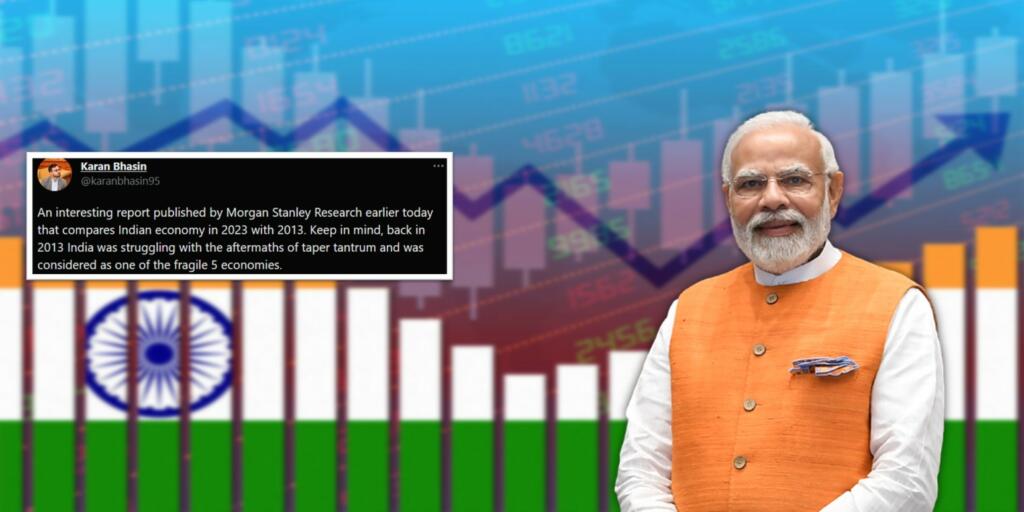Morgan Stanley report on India: In a global financial landscape riddled with uncertainty and volatility, India is making waves, demonstrating remarkable resilience and growth. Reflecting the growing confidence in these transformative policies, the multinational financial behemoth, Morgan Stanley, has given a ‘double thumbs up’ to Modinomics, confirming its positive outlook on the thriving Indian economy.
Let’s analyze the Morgan Stanley’s views on the current Indian economy, and why the Morgan Stanley report on India is optimistic on the current dynamics of Modinomics.
Morgan Stanley report on India: Comparing India of 2023 with India of 2013
Just a decade ago, in 2013, the Indian economy was grappling with the aftermath of the taper tantrum, an episode that saw emerging markets crumble as the US Federal Reserve hinted at reducing its quantitative easing policy. During this period, India found itself bundled with Brazil, South Africa, Indonesia, and Turkey, earning the unfortunate moniker of the “fragile five”. These were economies particularly vulnerable to external shocks due to their significant current account deficits.
Fast forward to 2023, the economic landscape in India presents a stark contrast. Under the decisive leadership of Prime Minister Narendra Modi, the country has not only steadied its ship but has also embarked on a strong and resilient economic journey. The transformation and turnaround of the Indian economy are no small feats. They bear testimony to the effectiveness of the government’s economic policies, often referred to as Modinomics.
According to a report on India published by Morgan Stanley Research, one of the critical factors contributing to this turnaround has been the government’s successful efforts to formalize the economy. The introduction of measures such as the Goods and Services Tax (GST) and a focus on digital payments has broadened the tax base and improved tax compliance, thus bolstering India’s fiscal health.
Also read: Nominal GDP Growth at 16.1%? National Statistical Office releases India’s Economic accomplishment
In addition to economic formalization, there has been a significant push towards building a modern welfare stack in India. The government has leveraged technology to improve the delivery of social benefits, ensuring aid reaches the intended beneficiaries promptly and without dilution. Initiatives such as the Direct Benefit Transfer (DBT) scheme have drastically reduced leakages and improved the efficacy of welfare programs.
What does the report indicate?
The manufacturing sector and capital expenditure (capex) have seen an impressive upswing over the years. Prime Minister Modi’s flagship program, “Make in India,” aims to transform India into a global manufacturing hub, while the government’s focus on infrastructure development has stimulated capital expenditure. Both of these factors have not only contributed to economic growth but have also generated employment opportunities, bolstering income and consumption levels.
The Morgan Stanley report provides an interesting analysis of what these developments might mean for income distribution in India. It suggests a significant shift, predicting a substantial expansion in the population at the top of the income distribution over the next decade. In essence, more Indians are expected to climb the income ladder, indicating a rise in prosperity and economic well-being at a more granular, individual level. This shift would signify not just macroeconomic success but microeconomic progress, benefitting citizens across the social strata.
The buoyancy in the Indian economy is further highlighted by its stable growth trajectory. Morgan Stanley projects a less volatile growth path for India, backed by robust macroeconomic fundamentals. This stability is critical as it reduces economic uncertainty, thereby increasing investor confidence and potentially attracting more foreign direct investment (FDI) into the country.
Also read: India’s Resilience: A Zero Percent Chance of Recession
As we told you
Another encouraging development is the low risk of recession for the Indian economy. Like we mentioned before, Various credit rating agencies have underscored this sentiment, predicting a negligible chance of an economic downturn. This optimism further buttresses the confidence in the potential of the Indian economy under the umbrella of Modinomics.
In conclusion, the ringing endorsement from Morgan Stanley is a testament to the success of Modinomics. It underscores the focused efforts and strategic initiatives undertaken by the Modi-led government, which have collectively propelled India onto a promising economic path. It is a resounding affirmation of the Indian economy’s potential and the effectiveness of Modinomics. As the Indian economy continues to soar, the words of Morgan Stanley ring true – the sky indeed seems to be the limit for Modinomics.
Support TFI:
Support us to strengthen the ‘Right’ ideology of cultural nationalism by purchasing the best quality garments from TFI-STORE.COM
